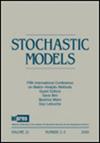随机微分方程模型的收获优化:最优是好的敌人吗?
IF 0.7
4区 数学
Q4 STATISTICS & PROBABILITY
引用次数: 1
摘要
摘要我们可以使用随机微分方程来描述在随机变化的环境中收获种群的大小演化。之前,我们比较了四种收割策略的利润表现:(i)基于可变努力的最优可变努力策略;(ii)最优惩罚可变努力策略,基于在努力上包括人工运行能量成本的惩罚版本;(iii)阶梯式政策,阶梯式政策是在每年年初(或每两年期)确定收割工作量,并在当年(或两年期)保持不变;(iv)基于持续努力的持续收获努力可持续政策。它们具有不同的性质,因此也值得研究这些政策的组合,并研究处罚金额、步骤的存在和类型以及对允许的最小和最大努力的限制的单一和交叉影响。使用基于实际收获人口的数据,并考虑逻辑增长模型,我们对纯政策和混合政策在利润、适用性和其他相关性质方面进行了比较研究。我们最终回答了一个问题:善的最佳敌人是什么?本文章由计算机程序翻译,如有差异,请以英文原文为准。
Harvesting optimization with stochastic differential equations models: is the optimal enemy of the good?
Abstract We can describe the size evolution of a harvested population in a randomly varying environment using stochastic differential equations. Previously, we have compared the profit performance of four harvesting policies: (i) optimal variable effort policy, based on variable effort; (ii) optimal penalized variable effort policies, penalized versions based on including an artificial running energy cost on the effort; (iii) stepwise policies, staircase versions where the harvesting effort is determined at the beginning of each year (or of each biennium) and kept constant throughout that year (or biennium); (iv) constant harvesting effort sustainable policy, based on constant effort. They have different properties, so it is also worth looking at combinations of such policies and studying the single and cross-effects of the amount of penalization, the absence or presence and type of steps, and the restraints on minimum and maximum allowed efforts. Using data based on a real harvested population and considering a logistic growth model, we perform such a comparison study of pure and mixed policies in terms of profit, applicability, and other relevant properties. We end up answering the question: is the optimal enemy of the good?
求助全文
通过发布文献求助,成功后即可免费获取论文全文。
去求助
来源期刊

Stochastic Models
数学-统计学与概率论
CiteScore
1.30
自引率
14.30%
发文量
42
审稿时长
>12 weeks
期刊介绍:
Stochastic Models publishes papers discussing the theory and applications of probability as they arise in the modeling of phenomena in the natural sciences, social sciences and technology. It presents novel contributions to mathematical theory, using structural, analytical, algorithmic or experimental approaches. In an interdisciplinary context, it discusses practical applications of stochastic models to diverse areas such as biology, computer science, telecommunications modeling, inventories and dams, reliability, storage, queueing theory, mathematical finance and operations research.
 求助内容:
求助内容: 应助结果提醒方式:
应助结果提醒方式:


